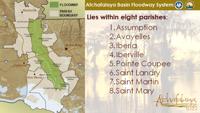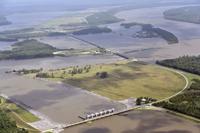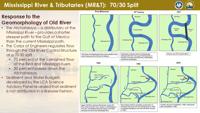
Posted on December 17, 2020
Gov. John Bel Edwards on Monday created a new Atchafalaya River Basin Restoration and Enhancement Task Force to help the state navigate the conflicting interests within the basin, including fishers, landowners, the oil and gas industry, and communities at risk of flooding.
The task force will also attempt to help integrate the use of the basin’s sediment-rich water resources with the state’s broader efforts to restore coastal wetlands that are starved for sediment.
“The irony of the Atchafalaya Basin is that while it is suffering from an abundance of sediment, the rest of our coast is experiencing a severe sediment deficit,” Edwards said in a news release announcing the task force.
“The basin’s stressors are not only harming water quality and the environment but also threatening the capacity of the basin to carry flood waters from the Mississippi and Red Rivers safely and effectively,” Edwards said. “The basin is the nation’s largest river-basin swamp with a rich ecology, and it is past time that it receive more focused attention here in Louisiana and nationally.”

The executive order directs the task force to submit an initial report by Sept. 1, 2021 that will focus on how to best manage navigation, flood control, economics and restoration within the basin and using the basin’s resources along the coast. The report will be submitted to the state Coastal Protection and Restoration Authority
The report also is expected to address sources of funding for basin projects and programs.
In 2018, the state Legislature transferred the state’s Atchafalaya Basin Program, which oversees an annual master plan, from the state Department of Natural Resources to the CPRA. The basin program is now submitted annually by the CPRA to the Legislature for approval at the same time that the broader master plan for coastal restoration and hurricane risk reduction is sent to the Legislature for approval.
Oversight over the basin is largely in the hands of the Army Corps of Engineers, however, which controls water flow through the federally regulated Atchafalaya Basin Floodway System.
The state is the non-federal sponsor for that system. But key decisions on the flow are made by Congress, which has long required that 30% of the Mississippi River’s flow be transferred to the Atchafalaya through the Old River Control Structure, north of Red River Landing.
When the Mississippi is at flood levels, the Corps also can increase the flow of water through Old River and open the Morganza Floodway to increase the flow into the Atchafalaya Floodway, a wide swath of land within the basin that the Corps maintains through easements.
The Corps limits use of the Morganza Floodway to years when the Mississippi River’s flow reaches about 1.5 million cubic feet per second. It has only been used twice, in 1973, which the Mississippi’s water flow threatened to break through the Old River Control Structure, and in 2011.
Corps officials announced that the floodway would be opened again in early 2019, but then decided against it when the Mississippi’s height dropped slightly.
When the Old River and Morganza are both used to increase the Mississippi’s flow to the Atchafalaya, it increases the chance of flooding to communities within the floodway, and to Morgan City and neighboring communities near the Atchafalaya’s mouth.
Repeated use of the Bonnet Carre Spillway to move water east into Lake Pontchartrain, rather than west into the Atchafalaya Basin, has been criticized by both Mississippi state and coastal county officials and by commercial oyster growers and fishers in Mississippi and southeastern Louisiana.
Legislation pending in Congress this year calls for the Corps to review how the Mississippi’s water is divided up during high water years.
Beginning in the mid-20th century, the sediment carried down the Atchafalaya has been filling large areas of the historic freshwater swamps within the basin. The creation of new land in wetland areas has been assisted by the spoil banks left behind when oil and gas exploration canals were built.
That’s led to conflicts between oil and gas companies and landowners and both recreational and commercial fishers, especially those who use the swamp as a source for wild crawfish.
Environmentalists also have raised concerns about how the sediment – and nutrients carried into the river from upstream farmers along the Mississippi – might be affecting wildlife in the Atchafalaya swamps.
The state also is interested in finding ways to redirect some of the sediment carried by the river into open water areas in the Terrebonne Basin to assist in wetland restoration efforts there.
The Atchafalaya also is fed by the Red River, which flows southeast from Arkansas – through Shreveport — to join up with Old River just west of the control structure.
The new task force will include:
- Representatives of the Governor’s Office of Coastal Activities, CPRA, the governor’s policy director, departments of Wildlife & Fisheries and Natural Resources, the state’s public lands administrator, and a representative of the Governor’s Advisory Commission on Coastal Protection, Restoration and Conservation;
- A representative from both the East and West Atchafalaya Basins, to be chosen from seven names submitted by parishes in the basins.
- Two representatives of landowners in the basin;
- Two representatives of conservation organizations active in the basin;
- Representatives of the energy transportation sector and inland navigation sector, and the Port of Morgan City;
- Representatives of the commercial fishing industry in the East and West Atchafalaya Basins, and a representative from the recreational fishing industry;
- A representative of an academic institution doing research in the basin.
During a briefing of the CPRA board last week on the plans for the governor’s executive order, Morgan Crutcher, a policy advisor in the Governor’s Office of Coastal Activities, said past proposals for new projects often ran into trouble because of conflicts between different basin users.
And an Atchafalaya Basin Conservation Fund created by the Legislature in 2008 was largely based on dwindling severance taxes and royalties, prompting the search for new revenue sources.
Source: nola







